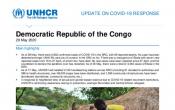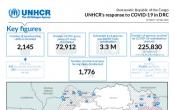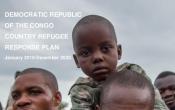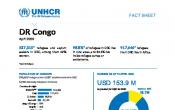Democratic Republic of the Congo
Operation: Democratic Republic of the Congo
Location
{"longitude":22,"latitude":-4,"zoom_level":5,"iso_codes":"'COD','GAB'"}
By clicking on the icons on the map, additional information is displayed.
The boundaries and names shown and the designations used on this map do not imply official endorsement or acceptance by the United Nations.
Key Figures
| 2019 year-end results | |
| 23,600 | IDP households and vulnerable members of host communities received core relief items |
| 17,450 | IDP households received shelter support in Ituri, North Kivu and South Kivu provinces |
| 17,400 | refugee returnees from Angola (2,600 organized returnees and 14,800 spontaneous returnees) benefited from cash assistance as part of their return package |
| 4,900 | IDP children received birth certificates in eastern DRC and Tanganyika province |
| 100 | community protection structures and IDP committees were established to work on sexual and gender-based violence prevention and interventions in North Kivu |
| 13 | IDP sites in North Kivu and 23 sites in Ituri Province were managed and supported by UNHCR |
| 2020 planning figures | |
| 100% | of primary school-aged children will be enrolled in primary education |
| 100% | SGBV survivors (refugees) receive appropriate support. |
| 319,720 | people of concern will be registered on an individual basis |
| 33,200 | people of concern will receive shelter support |
Latest Updates and Related Links
People of Concern
52%
Increase in
2019
2019
| 2019 | 7,699,931 |
| 2018 | 5,059,095 |
| 2017 | 5,145,780 |

[["Refugees",524193],["Asylum-seekers",3275],["IDPs",5014253],["Returned IDPs",2134349],["Returned refugees",23861]]
Loading ...
Democratic Republic of the Congo
< Back
2019
{"categories":[2015,2016,2017,2018,2019,2020],"budget":[207.82899883999997,209.71033615999997,234.31289883999997,198.877860264,155.86684905,168.21985667],"expenditure":[81.24654247999999,73.23818483,88.617526,91.8951266,109.65337005,null]}
{"categories":[2015,2016,2017,2018,2019,2020],"p1":[91.41104086,103.12806995999999,136.71162641,107.81339627,97.47881998999999,100.68534792],"p2":[2.69677526,1.923405,1.94889796,1.28578031,1.056962,5.7872832999999995],"p3":[38.54665211,29.819203039999998,29.873246,11.1438503,10.63418201,6.2334952800000005],"p4":[75.17453061,74.83965816,65.77912847,78.634833384,46.69688505,55.51373017]}
{"categories":[2015,2016,2017,2018,2019,2020],"p1":[57.354599990000004,58.9382084,65.13414131,56.675298340000005,58.0796307,null],"p2":[0.72133408,0.36397887,0.48065037,0.40466331,0.26290483000000003,null],"p3":[10.2698795,3.24760875,3.79706059,0.5195974,7.652771349999999,null],"p4":[12.90072891,10.688388810000001,19.20567373,34.295567549999994,43.65806317,null]}
Loading ...
CHOOSE A YEAR
- 2014
- 2015
- 2016
- 2017
- 2018
- 2019
- 2020
Operational context
Despite the high level of displacement in the Democratic Republic of the Congo (DRC), the political climate improved following elections in 2018, with a peaceful transition of power. However, while the scale of violence decreased in some regions, notably in the Kasai and Tanganyika, there was a sharp spike in Ituri, North Kivu and South Kivu provinces.UNHCR declared an internal level-3 emergency in these provinces in November 2019 to activate emergency procedures and in order to ensure access to additional human, material and financial resources. Continuing epidemics of Ebola, measles, cholera and malaria placed a further strain on the humanitarian situation.
Population trends
The DRC hosted over 523,700 refugees in 2019, mainly originating from Rwanda (41%), the Central African Republic (CAR) (33%), South Sudan (17%) and Burundi (9%). The DRC was also home to some 5 million IDPs as well as over 2.1 million IDPs who returned during 2019.At the end of December 2019, there were over 905,000 refugees and asylum-seekers from the DRC living in neighbouring countries, while some 23,800 Congolese refugees returned to the DRC over the course of the year.
Achievements
- UNHCR facilitated the voluntary repatriation of over 3,100 refugees from the DRC to the CAR.
- 100% of refugees from the CAR that had been targeted by livelihood interventions had their own business, or had been self-employed, for more than 12 months.
- UNHCR’s protection monitoring programme was reinforced, with an added emphasis on quality of analysis, dissemination of good practices, and more effective use of monitoring results for advocacy purposes.
- UNHCR reinforced its coordination of the protection cluster with dedicated provincial cluster coordinators.
- UNHCR also continued to co-lead the camp coordination and camp management (CCCM) working group with IOM in North Kivu and reinforced the working group’s role and presence in Ituri Province including through an increase in the number of sites managed (12 more sites managed by UNHCR and 39 more by IOM), more regular meetings, and an expansion in working group membership.
Unmet needs
- The operation was funded at 72% by the end of 2019.
- There was insufficient funding for secondary education in and outside of refugee camps.
- Lack of development actors in areas hosting refugees and IDPs hindered progress towards self-reliance and peaceful coexistence with local communities.
- Lack of a government-run system to register displaced people and track their movements hampered targeted planning and outreach to individuals with specific needs by humanitarian actors.
Working environment
The crisis in the Democratic Republic of the Congo is fuelled by ethnic and political conflicts. The already unstable security situation, particularly in the east of the country, is exacerbated by the electoral process, culminating in the presidential elections expected to be held on 23 December 2018. The risk of further displacement, sparked by inter-ethnic conflict, armed groups and civil unrest, in the lead up to the elections, and after the elections in 2019 remains high. These risks create a disastrous impact on the already precarious humanitarian situation in the DRC, and destabilising the Great Lakes region. The maintaining of humanitarian access and civilian character of asylum remains of concern for the coming year.UNHCR works closely with the Government, which maintains an open border and an out-of-camp policy for refugees. This is conducive to supporting UNHCR to move from a “care and maintenance” approach, focusing instead on durable solutions and self-reliance as a step towards the Comprehensive Refugee Response Framework and multi-year, multi-partner (MYMP) strategy for which consultations with the authorities have begun. UNHCR seeks to integrate refugees into national service delivery systems and frameworks, supporting both refugees and host communities, including through reinforcing partnerships with authorities, UN agencies, NGOs, and the private sector.
Key priorities
In 2019, UNHCR will focus on:- Ensuring a protective environment for people of concern while continuously emphasizing durable solutions, resilience and empowerment in order to gradually reduce assistance and dependency on humanitarian aid.
- Accentuating innovative approaches, enhancing cash assistance, strengthening livelihood opportunities and seeking new partners to ensure implementation.
- In accordance with the Refugee Coordination Model (RCM), continue to lead and coordinate efforts for refugees, while drawing on the support of other members of the Humanitarian Country Team.





















